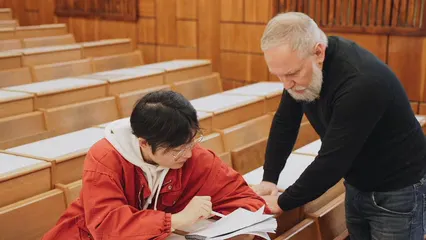Introduction
Nontraditional students are a diverse and dynamic group. They don’t fit the traditional mold of college students. Typically, these learners are over 25 years old, juggling work, family, and education. They are often financially independent and may have dependents of their own. This demographic is becoming increasingly significant in higher education. In fact, according to the National Center for Education Statistics (NCES), a whopping 74% of college students fall into the nontraditional category. Among these, approximately 37% are aged 25 or older. These statistics reveal a clear trend: as the workforce evolves, so does the makeup of our colleges and universities. This article aims to shine a spotlight on nontraditional students by examining various statistics related to their experiences. We’ll explore enrollment figures, demographics, and characteristics that define this growing population. As we navigate these numbers, we’ll uncover insights that highlight the challenges and opportunities nontraditional students face in today’s educational landscape. For those looking to balance life’s responsibilities while pursuing education, a Time Management for Non-Traditional Students Book can be a game changer. This guide offers practical tips to help you manage your time effectively, avoiding the stress of last-minute cramming or missed deadlines.Understanding Nontraditional Students
Definition and Characteristics
Nontraditional students are not just defined by their age. They often embody multiple characteristics that set them apart from traditional college students. Many of them have delayed their entry into higher education, often waiting a year or more after high school to enroll. This gap can be due to various reasons, including financial pressures or personal circumstances. Part-time enrollment is another common trait among nontraditional students. Many are balancing full-time jobs while taking classes. In fact, a staggering 64% of nontraditional students work while enrolled. This juggling act can include anything from long hours at work to caring for children or elderly family members. Let’s talk numbers! According to the Lumina Foundation, 24% of nontraditional students have dependents, while 49% are financially independent. These figures showcase the reality that many students are not just focused on their studies. They are managing complex lives that influence their educational journeys. For parents in this demographic, a Childcare Backpack Diaper Bag can make life a little easier. It’s designed for on-the-go parents, providing ample storage for all those baby essentials while keeping you organized. Demographically, nontraditional students are diverse. The NCES reports that 46% of them are first-generation college students, and they come from various racial and ethnic backgrounds. The growing representation of nontraditional students in higher education is not just a statistic; it’s a testament to the evolution of our educational landscape. In conclusion, understanding nontraditional students requires looking beyond age. It’s about recognizing the financial independence, employment status, and family responsibilities that shape their experiences. As this demographic continues to grow, educational institutions must adapt to meet their unique needs and support their success.
To gain deeper insights into the statistics of nontraditional students in college, you can explore statistics of nontraditional students in college scholarly.
Persistence and Retention Rates
Overview of Persistence and Completion Rates
When it comes to completing college, nontraditional students face a unique set of challenges. Statistics show significant differences in persistence and completion rates between nontraditional and traditional students. According to data from the Integrated Postsecondary Education Data System (IPEDS), traditional students often have a smoother path to graduation. For instance, 61% of first-time, full-time traditional students complete their degrees within eight years at four-year institutions. Conversely, nontraditional students—those who may attend part-time or juggle work and family responsibilities—often experience lower completion rates. Only 38% of non-first-time, part-time students earn their degrees within the same timeframe. This stark contrast highlights the hurdles nontraditional students must overcome. Financial strain, competing priorities, and lack of institutional support often contribute to these lower rates. The National Center for Education Statistics (NCES) adds more depth to this discussion. Their data indicates that only 20% of first-time, part-time students at two-year institutions complete their degrees within four years. This statistic reflects the ongoing challenges faced by those who balance education with work and family obligations.
Influencing Factors
Several factors influence the persistence and retention of nontraditional students. Financial issues rank high on the list. Tuition costs can be daunting, especially for those who may already be struggling to make ends meet. While financial aid is available, navigating the complexities of aid packages can be overwhelming. Many nontraditional students find themselves working full-time jobs, leaving them little time to focus on academics. Work-life balance is another significant challenge. Many nontraditional students juggle their academic responsibilities with family duties, such as childcare or eldercare. This juggling act can lead to stress and burnout, making it difficult to maintain academic momentum. The average nontraditional student might be a parent rushing to finish assignments between work shifts or a caregiver managing their time around medical appointments. If you’re looking to stay organized amidst the chaos, consider a Study Planner and Organizer. This handy tool can help you keep track of assignments, deadlines, and important dates, ensuring you don’t miss a beat while juggling your responsibilities. The availability of support services also plays a crucial role in retention rates. Institutions that offer robust academic advising, childcare services, and flexible scheduling options can dramatically improve the chances of success for nontraditional students. Studies show that when these students feel supported and understood, their likelihood of persisting in their studies increases significantly. In conclusion, while nontraditional students face hurdles that can hinder their academic journeys, understanding the factors affecting their persistence can help institutions develop strategies to better support them. By addressing financial challenges, promoting work-life balance, and enhancing support services, colleges can create pathways for nontraditional students to succeed and thrive.
Case Studies and Data Analysis
Research shows nontraditional students face unique hurdles in their academic journeys. A study by the National Center for Education Statistics (NCES) highlights that approximately 75% of college students today fall under the nontraditional category. This group includes students over 25, those with dependents, and individuals who work full-time while studying. The persistence rates of these students tell a compelling story. One significant finding indicates that only about 38% of non-first-time, part-time students earn a degree within eight years. In contrast, 61% of first-time, full-time traditional students complete their degrees in the same timeframe. This stark difference illustrates the challenges nontraditional students face. They often juggle responsibilities like work, family, and education, which can hinder their academic success. Institutions need to consider these statistics seriously. Implementing tailored support services can make a difference. For instance, academic advising and flexible scheduling are crucial in helping nontraditional students stay on track. A study from the Integrated Postsecondary Education Data System (IPEDS) emphasizes the importance of financial aid as well. Students who receive adequate financial support are more likely to persist and complete their degrees.
Institutional Responses and Best Practices
Support Services for Nontraditional Students
Nontraditional students face unique challenges that require tailored support services. Flexible scheduling is essential for these learners. Many juggle jobs, families, and academics. Providing options for evening or weekend classes can make a world of difference. Online courses are another crucial offering. They provide the flexibility that nontraditional students desperately need.


Marketing and Outreach Strategies
Engaging nontraditional students requires a different approach. Traditional marketing strategies may not resonate with this demographic. Colleges need to understand the unique needs and motivations of nontraditional students. Crafting targeted marketing campaigns is essential. Start by emphasizing career advancement. Many nontraditional learners return to school to enhance their job prospects. Highlight how specific programs align with workforce demands. Use real-life success stories from alumni to illustrate potential outcomes. Testimonials can build trust and inspire prospective students.

Recommendations for Higher Education Institutions
To truly support nontraditional students, colleges and universities must adopt tailored strategies. These strategies should address the unique challenges faced by this diverse group. Here are some actionable recommendations:- Flexible Learning Options: Offer evening, weekend, and online classes. This flexibility accommodates working students and those with family responsibilities.
- Robust Support Services: Implement dedicated support systems. These could include academic advising, financial aid counseling, and mental health resources. Such services help students navigate their educational journey.
- Childcare Services: Provide on-campus childcare. This enables student-parents to focus on their studies without worrying about their children’s care.
- Financial Assistance Programs: Streamline access to scholarships and grants. Many nontraditional students face financial hurdles. Simplifying the application process can make a significant difference.
- Career Counseling: Offer career services tailored to nontraditional students. This includes job placement assistance and internships. Students benefit from guidance in aligning their education with career goals.
- Community Building: Foster a sense of belonging. Organize networking events and peer support groups. These initiatives can help nontraditional students connect with one another and build a supportive community.
- Tailored Marketing Strategies: Engage nontraditional students with targeted marketing. Highlight programs that meet their specific needs and demonstrate how your institution can facilitate their goals.

FAQs
What is a nontraditional student?
A nontraditional student typically is someone who does not fit the traditional mold of college students, often defined by one or more characteristics. These can include being over 24 years old, having dependents, attending school part-time, or working full-time while enrolled. Examples include adult learners returning to school after a career break or individuals managing family responsibilities alongside their studies.
How do nontraditional students differ from traditional students?
Nontraditional students often differ significantly from their traditional counterparts in various aspects. They are usually older, often financially independent, and may have dependents. Their motivations for enrolling are typically career-focused, such as seeking promotions or changing career paths. Additionally, nontraditional students often face greater challenges related to time management, work-life balance, and financial pressures compared to traditional students.
What are the completion rates for nontraditional students?
Completion rates for nontraditional students tend to be lower than those of traditional students. For instance, only about 38% of non-first-time, part-time students earn their degrees within eight years, as opposed to 61% of first-time, full-time traditional students. Various factors influence these rates, including financial issues, work-life balance challenges, and institutional support services.
How can colleges better support nontraditional students?
Colleges can implement several effective strategies to support nontraditional students. These include offering flexible scheduling options, providing on-campus childcare, enhancing access to financial aid resources, and creating tailored academic support programs. Additionally, fostering a sense of community and belonging can significantly impact retention and success rates among this demographic.
All images from Pexels




